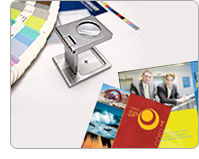- Products
-
Design Templates
- Featured Design Galleries
- More Galleries
- Services & Resources
- Free Sample Kit
- Deals
When it comes to booklet printing, nothing is faster and more cost-effective than online printing. Whether you need 25 booklets printed or 25,000, you'll find better pricing and more options at your fingertips through online printers such as PsPrint. Booklet covers are especially important, because that's the first thing people will see. But what's the best way to cover your booklets? Here we'll examine the pros and cons of different booklet cover options.
 Probably the most important booklet cover decision you'll make is what kind of paper to use. If you go with something too flimsy, your booklet will tear easily; if it's too stiff, your booklet will be difficult to browse through. In both cases potential customers won't read what you have to say. A 100-pound gloss cover stock is a good choice for most brochures, because it offers stability and the clean, glossy sheen adds punch to your colors. This type of paper stock is especially good for booklets with many pages due to the added support. For lighter booklets, you can go with an 80-pound text cover. It's less expensive than the 100-pound gloss cover, yet looks just as good; however, lighter paper tears easier and shouldn't be used if the booklets will get a lot of mileage. Fingerprints are prominent on gloss paper, so it's important to keep them clean for a crisp professional appeal. If gloss isn't your thing, you can try a 70-pound matte text stock for a softer look that often goes will with artistic designs. Matte papers hold up well and don't show dirt and fingerprints as easily as gloss papers, but they're more expensive than most gloss and do not display deep blacks and blues as well. For a large booklet, consider going with 100-pound gloss cover stock for the outside of your booklet and using 80-pound gloss or 70-pound matte for the inside dividers.
Probably the most important booklet cover decision you'll make is what kind of paper to use. If you go with something too flimsy, your booklet will tear easily; if it's too stiff, your booklet will be difficult to browse through. In both cases potential customers won't read what you have to say. A 100-pound gloss cover stock is a good choice for most brochures, because it offers stability and the clean, glossy sheen adds punch to your colors. This type of paper stock is especially good for booklets with many pages due to the added support. For lighter booklets, you can go with an 80-pound text cover. It's less expensive than the 100-pound gloss cover, yet looks just as good; however, lighter paper tears easier and shouldn't be used if the booklets will get a lot of mileage. Fingerprints are prominent on gloss paper, so it's important to keep them clean for a crisp professional appeal. If gloss isn't your thing, you can try a 70-pound matte text stock for a softer look that often goes will with artistic designs. Matte papers hold up well and don't show dirt and fingerprints as easily as gloss papers, but they're more expensive than most gloss and do not display deep blacks and blues as well. For a large booklet, consider going with 100-pound gloss cover stock for the outside of your booklet and using 80-pound gloss or 70-pound matte for the inside dividers.
Some designs call for a black and white cover; but in most cases you'll want to go with full-color printing for your booklet cover. While it is cheaper to print in black and white, today's modern offset and digital presses have dramatically reduced the costs associated with vivid full-color printing, which is proven to attract more attention faster. Likewise, you can opt for one-sided booklet cover printing, but you won't save much money and you'll also sacrifice valuable real estate to place important information or to enhance your sales pitch.

There are two basic ways to bind a booklet: A saddle-stitch or a Wire-O. Wire-O binding cost more, but it is also more attractive and holds the pages together much longer, especially when it comes to large booklets. Saddle-stitching, or stapling along the folded edge, is cheaper but the staples used are prone to falling out and leaving your pages scattered. Saddle-stitching is a good option for small, lightweight booklets, but if you have a large multi-page booklet and/or a thick cover, you'll want to go with Wire-O binding. Remember that your booklet is a reflection of your company. It not only has to look great, it has to feel stable and solid in your customers' hands to put them in the right mindset about your company. Good materials mean your booklets will have a longer shelf life, which also increases the opportunity each booklet will have of being picked up by a potential customer.